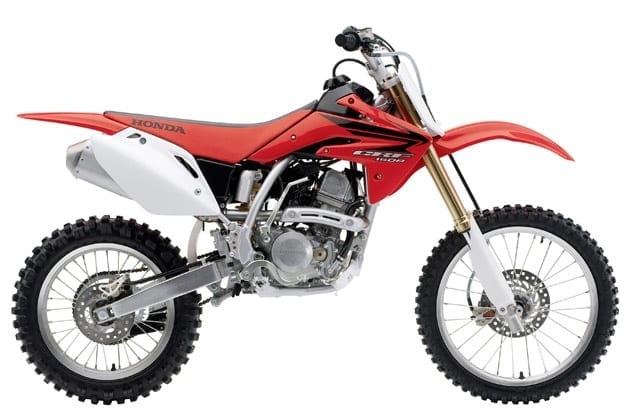Scorpa's different strokes
By TMX Archives on 2nd Nov 06

SCORPA has really been burning the midnight oil to assemble a wide-ranging, up-to-date range of trials model for 2007 and we are pleased to kick-off with first-impressions of THREE very different bikes from the French factory: the brand-new SY250F, the uprated two-stroke SY250, and the updated air-cooled TY175FR.
The SY250 is considerably boosted thanks to a new, more robust exhaust system, new cylinder head, heavier flywheel, lower footrests, new rear mudguard and new shock. The rear shock has transformed the Scorpa backend and if you have previously tried a Scorpa and been put-off by that previously very bouncy feel then the time has come for another test ride - you'll be suprised!
All-new SexY 250F
HAVING had quite a while to study and look around the latest 2007 model range from Scorpa, whilst McMilne sought the perfect static shots next to the river, I found myself looking forward to testing these three models, I was particularly interested to try the SY250F as it's the closest machine to the Montesa 4RT that I have ridden for the last two years. Time to put a few scuffs on these immaculate looking trials irons I thought!
Cracking the 250F into life is a very simple job, choke lever on the clutch master cylinder, pull the lever back and just kick the bike over. Second kick and the SY250F burbled into life.
My initial expectations, having watched Scorpa factory ace Taddy Blazusiak training at Hawkstone World trial this year, was that this machine was going to feel like a fire-spitting, high-compression 250F MX-derived motor - in fact it was quite the opposite.
The bike has a very neutral feeling when you first ride it and by that I mean that there is no bias as in front end heavy or a feeling of the bike being top heavy either. I found the SY250F very easy to move around, both front and back end are easy to manoeuvre and the only obvious reason for this is that the Scorpa technicians have put a great deal of thought into the design of the chassis and how this bike has to appeal to the masses and not just World Championship runners.
The carbureted motor has an almost old school four-stroke feeling to it. You can get away with being pretty aggressive with this engine and it has no signs of biting the hand that feeds it. Over some very greasy rock sections, the bottom end and mid-range power allows you to concentrate on riding rather than being conscious of what to do with the throttle if you lose traction. I used first gear for pretty much every section as it's quite a tall gear. Second is OK if you need more momentum but I found third gear too much for most sections. Front wheel stability is very good, when you try to catch your balance the slightest movement of the handlebars stands you back up.
Clutch action and operation initially felt very spongy and I thought we would need to keep adjusting it. This wasn't the case although I think for a more advanced rider maybe a smaller AJP master cylinder could speed up the clutch action for riding more advanced sections.
Front forks worked as you would expect for the latest Paioli units, one interesting note was that the forks never bottomed out, even at the bottom of a steep descent. Normally with a four-stroke this is the worst trait, when you have a drop followed by a sharp turn it can often be difficult to take the weight off the front wheel to allow the turn.
Rear shock gave me no cause for concern as it worked over the smallest rocks and when the bike was thrown at something bigger, it soaked up the thump pretty well.
In summing up I would say that between Montesa and Scorpa they have done a great deal of four-stroke development based on proven MX technology. I must say that I think the route Montesa took with the fuel injection system is still the hassle-free way to fly a modern four-stroke, assuming it doesn't ever play up! The SY250F certainly opened my eyes and anyone thinking of converting from two to four-stroke needs to have a good test ride on this bike as it is certainly going to be a force to be reckoned.
With Yamaha and test riders with the experience of Marc Colomer, Scorpa are certainly serious about four-stroke trials bikes.
A touch of two-stroke magic
THIS bike was absolutely brand new out of the box and hadn't turned a wheel before our test and I have to say my expectations of this bike were quite high having seen them in competition for a few years now. The 2007 two-stroke features changes that include a higher compression ratio, heavier flywheel and a re-worked middle exhaust and rear silencer. As with all Japanese-engined bikes, they need lots or running in time due to close manufacturing tolerances.
My first impressions were that the footrests seemed quite high and the front wheel felt low. Having said that, I had just climbed off a fairly lengthy test on the SF250F which has a completely different riding position.
As this bike was so new we decided to give it a thrash over the fell just to see her up to working temperature, get the fan working and to try bed the suspension in a bit. Riding up some small loose rocky gullies I soon felt at ease with the bike and found it quite smooth and easy to ride. We tested the bike on some very greasy off-camber grass banks with a few rock slabs chucked in for good measure. I really wanted to have a good test ride on this model to try and settle the four-banger versus two-pinger argument of which grips the best.
I first rode the section six or seven times on the two-stroke without a great deal of success, finding I had to really nurse the bike through on each attempt. I then got onto the four-stroke, put it into first gear and on the next five attempts is was like having traction control switched on, the 4T made mincemeat of this hazard. One thing we noticed was that as the section deteriorated, the four-stroke began to struggle for grip and almost felt like it was just slipping on the surface and wouldn't dig in for grip. Back onto the two-stroke and - just as I had expected I had no problems now the section was really muddy. This bike was now much easier to find grip with and it felt as though it could dig into the ground to find grip.
Having ridden both four and two-stroke enduro bikes, it is exactly the same feeling. Both do the job really well but in their own way. In some conditions a different technique is sometimes required. In short, when it's greasy terrain a four-stroke is better but once you're in the mud, a two-stroke will burn its way through to find traction far better. This is due to a two-stroke having the ability to spin the wheel faster to clear the mud out then carry on gripping. Try it for yourself sometime!
It is horses for courses - each model has its advantages and disadvantages.
The SY250 feels very small when you stand on it and the only criticism I have on this bike is that on a couple of occasions I did catch my leg on the end of the silencer, although I admit that my legs are longer than most. The only other gripe I have on the whole Scorpa range was that the 1980s Domino grips were awful, hard on your hands and just old fashioned. I has them on my Gas Gas in 1989 and they were awful then! So Mr Scorpa, please buy some of them new up-to-date trick Domino grips for the '08 bikes! Meanwhile, when you buy your SY250, get your dealer to chuck in a pair of decent grips to seal the deal!
As this is the only two-stroke Japanese powered machine available since Montesa decided to go four-stroke only, it makes it the obvious choice for anyone who likes Japanese build-quality and two-stroke power.
Baby gets a 160 boost
HAVING looked at this bike for the first time in the showroom at Birkett Motosport I have to say the Rossi-Replica graphics on this little beauty looked the biz. But underneath the glitz my first impression of this bike was that it's just an air-cooled - dare I say it - Long Ride/ trail derived, no frills trials iron.
But, this bike is now built around the old SY250 two-stroke chassis and it has been transformed into a proper little trials iron and not the trail bike that it started life as a couple of years ago.
Time to give it a spin and the first section I rode was a Lakes Two Day straight-forward stream section which I thought I would have needed a medal for getting this bike up! To my surprise, it was really quite good fun to ride and the weight of the bike is the first thing I noticed... it hasn't got any! It's so light to ride it feels like a toy. The engine is the kind of motor you would really like to keep buzzing but having said that it does pull very well, even with my slight 13 stone sat on it.
Being precise on this bike isn't that important as it has no hidden agenda and you can just bully it to where you want to go. Grip on this bike was never a problem as the way the engine works and due to its small capacity it doesn't really have enough power for you to have to worry about wheel spin. The best way to ride this bike is however you want as you are firmly the boss of the bike and not the other way round.
Clutch operation was very agricultural due to the old fashioned cable operation and not nice to use at all. However - this bike was one of three prototypes and the first batch of production bikes will have a hydraulic conversion fitted so that should sort the little problem out.
Suspension and brakes worked as expected throughout the test, although for me I found the rear brake pedal was mounted quite high and on a couple of occasions I did miss the pedal. This could be probably be changed or even adjusted out.
My opinion is that all this bike needs is a little bit more of the nice billet CNC-machined parts like the ones fitted to the other Scorpa models to help it find its way out of the UK Scorpa dealer network.
This bike is only a 163 cc and is aimed at the Beginner/ Novice market, is really good fun to ride and ought to prove fairly maintenance free. It also comes with the option of red/ black graphics or the yellow black as fitted to our test machine so like just like 'The Doctor' you could change the livery of your machine when you like, just don't try riding it as fast as him!
Specification:
